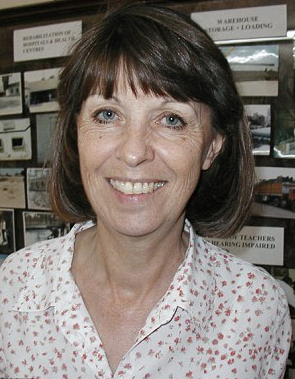Margaret Hassan (Margaret Fitzsimons)

Margaret Hassan was born Margaret Fitzsimons in Dalkey, County Dublin, Ireland, to parents Peter and Mary Fitzsimons. However, soon after the end of World War II her family moved to London, England, where she spent most of her early life and where her younger siblings were born. At the age of twenty seven, she married Tahseen Ali Hassan, a twenty-nine-year-old Iraqi studying engineering in the United Kingdom. She moved to Iraq with him in 1972, when she began work with the British Council of Baghdad, teaching English. Eventually she learned Arabic and became an Iraqi citizen, as was required of foreigners under Saddam Hussein’s government. She remained a Roman Catholic throughout her life and never converted to Islam as was widely reported after her death. A requiem Mass was held for her, after her death was confirmed, at Westminster Cathedral by Cardinal Cormac Murphy-O’Connor. During the early 1980s, Hassan became the assistant director of studies at the British Council; later in the decade she became director. Meanwhile, Tahseen worked as an economist. She remained in Baghdad during the 1991 Gulf War, although the British Council suspended operations in Iraq, and she was left jobless at the end of it.
Margaret Hassan joined humanitarian relief organisation CARE International in 1991, the aid group having established itself in Iraq during that year. Sanitation, health, and nutrition became major concerns in the sanctioned Iraq; she became a vocal critic of the United Nations restrictions. She was opposed to the United States invasion of Iraq in 2003, arguing before it that the Iraqis were already “living through a terrible emergency. They do not have the resources to withstand an additional crisis brought about by military action”. Margaret was crucially involved in bringing leukaemia medicine to child cancer victims in Iraq in 1998. By 2004, she was head of Iraqi operations for CARE. Well known in many of Baghdad’s slums and other cities, Hassan was especially interested in Iraq’s young people, whom she called “the lost generation”. Her presence could draw large crowds of locals. Margaret Hassan was kidnapped in Baghdad on 19 October 2004, and was killed some weeks later on 8 November. In a video released of her in captivity she pleaded for the withdrawal of British troops. She stated that “these might be [her] last hours”, “Please help me. The British people, tell Mr. Tony Blair to take the troops out of Iraq and not bring them here to Baghdad”, and that she did not “want to die like Mr. Bigley”, a reference to Kenneth Bigley, who had been murdered in Iraq only weeks earlier. Patients of an Iraqi hospital (where her work had some effect) took to the streets in protest against the hostage takers’ actions. On 25 October, between 100 and 200 Iraqis protested outside CARE’s offices in Baghdad, demanding her release. Prominent elements of the Iraqi insurgency, such as the Shura Council of Fallujah Mujahideen, along with Iraqi political figures such as the Shia cleric Grand Ayatollah Ali al-Sistani, condemned the kidnapping and called for her release.
On 2 November, Al Jazeera reported that the kidnappers threatened to hand her over to the group led by Abu Musab al-Zarqawi who were responsible for the murder of Kenneth Bigley. On 6 November, a statement purportedly from al-Zarqawi appeared on an Islamist website calling for the release of Ms. Hassan unless the kidnappers had information she was aligned with the invading coalition. However, the statement could not be authenticated. Hassan’s whereabouts were unknown in the video. On 15 November, US Marines in Fallujah uncovered the body of an unidentified blonde- or grey-haired woman with her legs and arms cut off and throat slit. The body could not be immediately identified, but was thought unlikely to be Hassan, who had brown hair. There was one other western woman known missing in Iraq at the time the body was discovered, Teresa Borcz Khalifa, 54, Polish-born and also a long-time Iraqi resident. Khalifa was released by her hostage takers on 20 November. On 16 November, CNN reported that ‘CARE’ had issued a statement indicating that the organisation was aware of a videotape showing Hassan’s murder. Al-Jazeera reported that it had received a tape showing Hassan’s murder but was unable to confirm its authenticity. The video showed Hassan being shot with a handgun by a masked man. It is not clear who was responsible for Margaret Hassan’s abduction and murder. The group holding her never identified itself in the hostage videos.
Born
- April, 18, 1945
- Dalkey, Republic of Ireland
Died
- November, 16, 2004
- Iraq
Cause of Death
- gunshot wounds



